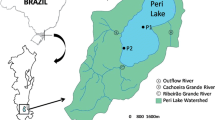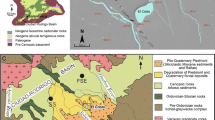Abstract
In this paper, Lake Taihu, a large shallow freshwater lake in China, is chosen as an example of reconstruction of eutrophication through the comparison between stable isotopes from dissolved nutrients and plants and water column nutrient parameters and integration of multiple proxies in a sediment core from Meiliang Bay including TN, TP, TOC, C/N, δ 15N, δ 13C, etc. Differences in aquatic plant species and trophic status between East Taihu Bay and Meiliang Bay are indicated by their variations in δ 13C and δ 15N of aquatic plants and δ 15N of NH4 +. A significant influence of external nutrient inputs on Meiliang Bay is reflected in temporal changes in δ 15N of NH4 + and hydro-environmental parameters. The synchronous change between δ 13C and δ 15N values of sedimented organic matter (OM) has been attributed to elevated primary production at the beginning of eutrophication between 1950 and 1990, then recent inverse correlation between them has been caused by the uptake of 15N-enriched inorganic nitrogen by phytoplankton grown under eutrophication and subsequent OM decomposition and denitrification in surface sediments, indicating that the lake has suffered from progressive eutrophication since 1990. Based on the use of a combination of stable isotopes and elemental geochemistry, the eutrophication of Meiliang Bay in Lake Taihu could be better traced. These transitions of the lake eutrophication respectively occurring in the 1950s and 1990s have been suggested as a reflection of growing impacts of human activities, which is coincident with the instrumental data.
Similar content being viewed by others
References
Teranes, L. J., Bernasconi, M. S., The record of nitrate utilization and productivity limitation provided by δ 15N values in lake organic matter-A study of sediment trap and core sediments from Baldeggersee, Switzerland, Limnol. Oceanogr., 2000, 45(4): 801–813.
Meyers, P. A., Organic geochemical proxies of paleoceanographic, paleolimnologic and paleoclimatic processes, Org. Geochem., 1997, 27(5/6): 213–250.
Hollader, D. A., McKenzie, J. A., CO2 control on carbon isotope fractionation during aquatic photosynthesis: A palaeo-pCO2 barometer, Geology, 1991, 19: 929–932.
Hodell, D. A., Schelske, C. L., Production, sedimentation and isotopic composition of organic matter in Lake Ontario, Limnol. Oceanogr., 1998, 43: 200–214.
Wu, J. L., Gagan, M. K., Jiang, X. et al., Sedimentary geochemical evidence for recent eutrophication of Lake Chenghai, Yunnan, China, J Paleolimn., 2004, 32: 85–94.
Schelske, C. L., Hodell, D. A., Using carbon isotopes of bulk sedimentary organic matter to reconstruct the history of nutrient loading and eutrophication in Lake Erie, Limnol. Oceanogr., 1995, 40(5): 918–929.
Brenner, M., Whitmore, T. J., Lasi, M. A. et al., Stable isotope (δ 13C and δ 15N) signatures of sedimented organic matter as indicators of historical lake trophic state, J Paleolimn., 1999, 22: 205–221.
Wang, S. M., Dou, H. S., Memoirs of Lakes in China (in Chinese), Bei**g: Science Press, 1998, 261–268.
Qu, W. C., Wang, S. M., Zhang, P. Z. et al., Classifying lake types using biological markers, Oceanologia et Limnologia Sinica (in Chinese with English abstract), 2000, 31(5): 530–534.
Qin, B. Q., Hu, W. P., Chen, W. M. et al., Process and Mechanism of Environmental Changes of the Taihu Lake (in Chinese), Bei**g: Science Press, 2004, 19–33.
Michael, J. S., Examination of water for pollution (volume 2), World Health Organisation Region Office for Europe, 1980, 258.
Lu, R. K., Methods of Soil Science and Agricultural Chemistry Analysis (in Chinese), Bei**g: China Agricultural Science and Technology Press, 2000, 558–562.
**, X. C., Tu, Q. Y., Criteria of Evaluating Lake Eutrophication (2nd edition) (in Chinese), Bei**g: China Environmental Science Press, 1990, 159–206.
Rose, N. L., Boyle, J. F., Du, Y. et al., Sedimentary evidence for changes in the pollution status of Taihu in the Jiangsu region of eastern China, J. Paleolimn., 2004, 32(1): 41–51.
Wu, J. L., Wang S. M., Climatic variations in the past 140 ka recorded in core RM, east Qinghai-**zang Plateau, Science in China, Series D, 1997, 40(4): 443–448.
Rosenmeier, M. F., Hodell, D. A., Brenner, M. et al., A 4000-year lacustrine record of environmental change in the southern Maya lowland, Peten, Guatemala, Quat. Res., 2002, 57: 183–190.
Smith, B. N., Epstein, S., Two categories of 13C/12C ratios for higher plants, Plant Physiology, 1971, 47: 380–384.
Stuiver, M., Climate versus changes in content of organic component of lake sediment during the Late Quarternary, Quat. Res., 1975, 5: 252–262.
Meyers, P. A., Ishiwatari, R., Lacustrine organic geochemistry-an overview of indicators of organic matter sources and diagenesis in lake sediments, Org. Geochem., 1993, 7: 867–900.
Peterson, B. J., Howarth, R. W., Sulfur, carbon, and nitrogen isotopes used to trace organic matter flow in the salt-marsh estuaries of Sapelo Island, Georgia, Limnol. Oceanogr., 1987, 32: 1195–1213.
Meyers, P. A., Preservation of source identification of sedimentary organic matter during and after deposition, Chem. Geol., 1994, 144: 289–302.
Meyers, P. A., Leenheer, M., Bourbonniere, R., Diagenesis of vascular plant organic matter components during burial in lake sediments, Aquatic Geochem., 1995, 1: 35–52.
Fogel, M. L., Cifuentes, L. A., Isotope fractionation during primary production, Organic Geochemistry (eds. Macko, S. A., Engel, M. H.), New York: Plenum Press, 1993, 73–94.
Keely, J. E., Sandquist, D. R., Carbon: freshwater plants, Plant Cell Environment, 1992, 15: 1021–1035.
Bernasconi, S. M., Barbieri, A., Simona, M., Carbon and nitrogen isotope variations in sedimenting organic matter in Lake Luagano, Limnol. Oceanogr., 1997, 42(8): 1755–1765.
McKenzie, J. A., Carbon isotopes and productivity in the lacustrine and marine environment, Chemical Processes in Lakes (ed. Stumm, J.), New York: Wiley, 1985, 99–118.
Herczeg, A. L., A stable isotope study of dissolved inorganic carbon in a softwater lake, Biogeochemistry, 1987, 4: 231–263.
Cifuentes, L., Sharp, J., Fogel, M., Stable carbon and nitrogen isotope biogeochemistry in the Delaware estuary, Limnol. Oceanogr., 1988, 33: 1102–1115.
Schelske, C., Hodell, D., Recent changes in productivity and climate of Lake Ontario detected by isotopic analysis of sediments, Limnol. Oceanogr., 1991, 36: 961–975.
Macko, S., Engel, H., Parker, P., Early diagenesis of organic matter in sediments: Assessment of mechanisms and preservation by the use of isotopic molecular approaches, Organic Geochemistry: Principles and Applications (eds. Engel, M. H., Macko, S. A.), New York: Plenum Press, 1993, 211–224(Chapter 9).
Macko, S., Pereira, C., Neogene paleoclimate development of the Antarctic Weddell Sea region: Organic geochemistry, Proceedings of the Ocean Drilling Program Part B: Initial Reports of the Ocean Drilling Program (eds. Barker, J., Kennett, J. P. et al.), Texas A&M University, Part B, 113, 1990, 881–897.
Meyers, P. A., Tenzer, G., Lebo, M. E. et al., Sedimentary record of sources and accumulation of organic matter in Pyramid Lake, Nevada over the past 1000 years, Limnol. Oceanogr., 1998, 43: 160–169.
Herczeg, A. L., Smith, A. K., Dighton, J. C., A 120 year record of changes in nitrogen and carbon cycling in Lake Alexandrina, South Australia: C:N, δ 13C and δ 15N in sediments, Appl. Geochem., 2001, 16: 73–84.
Kendall, C., Tracing nitrogen sources and cycling in catchments, Isotope Tracers in Catchment Hydrology (eds. Kendall, C., McDonnell, J. J.), Amsterdam: Elsevier, 1998, 519–576(Chapter 16).
**ng, G. X., Cao, Y. C., Shi, S. L. et al., N pollution sources and denitrification in waterbodies in the Taihu Lake region, Science in China, Series B, 2001, 44(3): 304–314.
Chen, J. S., Aquatic environmental chemistry (in Chinese), Bei**g: Higher Education Press, 1987, 176–188.
Huh, C. A., Fluxes and budgets of authropogenic metals in the Santa Monica and San Pedro Basins off Los Angeles—review and reassessment, Sci. Total Environ., 1996, 179: 47–60.
Zhang, J., Some progresses in estuarine geochemical studies of China, Oceanologia et Limnologia Sinica (in Chinese with English abstract), 1994, 25(4): 438–445.
Szefer, P., Szefer, K., Glasby, G. P. et al., Heavy metal pollution in surficial sediments from the southern Baltic Sea of Poland, J. Environmental Science, part A: Environ Sci Eng Toxic Hazard Subst Control, 1996, A31(10): 2723–2754.
Bakan, G., Balkas, T., Enrichment of metals in the surface sediments of Saponca Lake, Water Environmental Research, 1999, 71: 71–74.
Talbot, M. R., Lærdal, T., The late Pleistocene-Holocene palaeolimnlolgy of Lake Victoria, East Africa, based upon elemental and isotopic analyses of sedimentary organic matter, J. Paleolimn., 2000, 23: 141–164.
Author information
Authors and Affiliations
Corresponding author
Rights and permissions
About this article
Cite this article
Lin, L., Wu, J. & Wang, S. Evidence from isotopic geochemistry as an indicator of eutrophication of Meiliang Bay in Lake Taihu, China. SCI CHINA SER D 49 (Suppl 1), 62–71 (2006). https://doi.org/10.1007/s11430-006-8106-8
Received:
Accepted:
Issue Date:
DOI: https://doi.org/10.1007/s11430-006-8106-8




